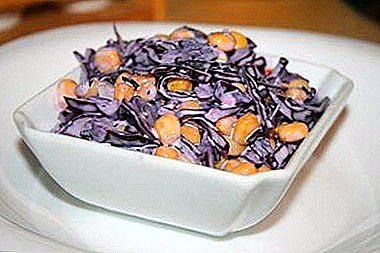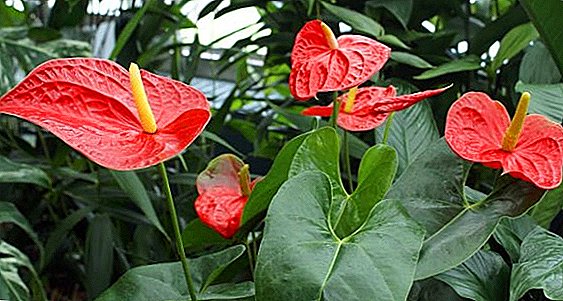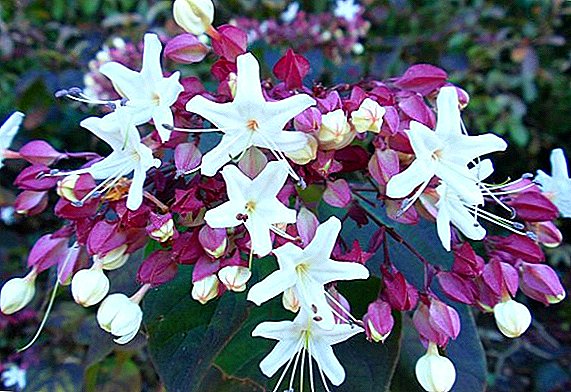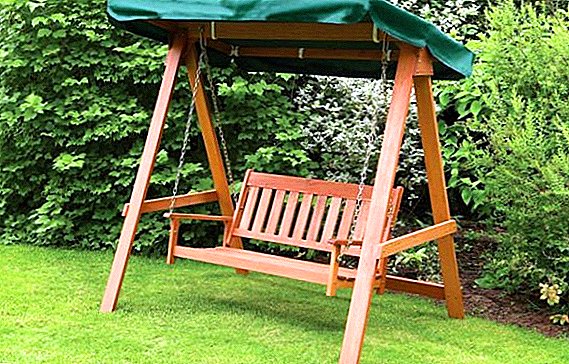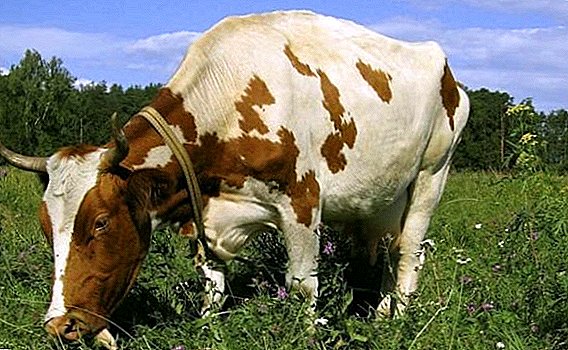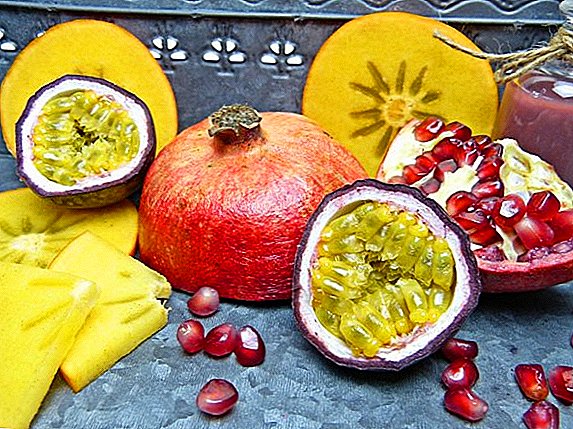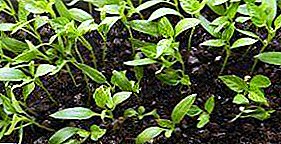 Thinking about the fact that it would be nice to lay the foundation for their own collection of flowers, many are striving to find the brightest views. But the seemingly gorgeous “exotics”, after some hesitation, fall out of the list - they are difficult to maintain, and their prices are very high. Then more familiar lines come into the view, which are distinguished by docile "temper". Among those was terry balsam.
Thinking about the fact that it would be nice to lay the foundation for their own collection of flowers, many are striving to find the brightest views. But the seemingly gorgeous “exotics”, after some hesitation, fall out of the list - they are difficult to maintain, and their prices are very high. Then more familiar lines come into the view, which are distinguished by docile "temper". Among those was terry balsam.
Botanical description
This name carries a whole range of single- and perennial herbaceous plants of the order Heatherflower, which is divided into 2 genera: Impatiens and Hydrocera. 
In the indoor gardening the most popular flowers of the first of these genera (it has more than 500 species). The most widespread of them is the Waller balsam, which is most popular among gardeners all over the world.
Herbal perennial flowers also include such as licoris, nemesia, phlox paniculata, adonis, grassy hibiscus, lunik, bromelia, iberis, errigeron.
This perennial grows up to 15-60 cm in height and is distinguished by the diversity of the shape of the bush. The fact is that this line "in its pure form" has become the parent for a huge number of hybrids, which can be spherical and pyramidal, upright or creeping. For this balsam traditional red or pink color flowers.
Such flowers are conventionally assigned to the first species group.
Plants of the second group are already low (15-30 cm) hybrids, often used for gardening open areas as letniki or growing on balconies. 
Important! Hybrid lines marked with F1 are more resistant to drought.
The leaves of all balsams are green, lanceolate, dentate or whole. They have no stipule, and they are arranged alternately.
You will also be interested to learn about the cultivation of garden balsam, room balsam, novogvineysky balsam.
During the flowering period, at the edges of fleshy stems, single (less often - gathered in loose inflorescences) flowers of irregular shape are visible. Rising above the leaves, they make the bush look like a bouquet.
Under room conditions, flowering usually lasts 6-8 months, and at a suitable temperature - all year round. On open ground, it starts from the first days of summer and lasts until the first frost.
Fruits - juicy oblong multi-seed boxes with five leaves each. When they open, you can collect light seeds (about 100 pieces per 1 g of weight). 
Distribution and habitat
The area of balsam includes countries in Africa and Asia, Europe and North America.
But most of all the species are still found in tropical rainforests: the huge arrays of these plants are concentrated in the green belt of Indochina and Africa, as well as on. Sumatra and Madagascar.
In temperate climates, these plants are found up to coniferous taiga forests. For example, in the central regions of Siberia, the balsam of the forest grows, which is a brother of indoor lines.
Did you know? The first copies of these plants came to Europe in 1596. In fact, home gardening in its current sense began from the cultivation of balsams.

Favorite locations are semi-shaded or open areas with moderately wet soils: near trees, along rivers or streams, and also in shrubs covering ravines.
Use in landscape design
Due to their catchy appearance, these flowers are widely used to decorate open areas.
The most common balsams can be seen as an element of the following decorations:
- a classic mixborder flower garden that looks great in combination with a green lawn;
- undersized forms are perfect for border decoration - if you plant species with different colors of flowers, it will distract attention from the enclosing structure at a purely visual level;
- balsamic gardens - many do not combine balsam with other plants, preferring to plant arrays from different lines in color: such a play of tones very much revives the site and looks spectacular, because the same height specimens merge into a living monolith that changes shade;
- stony compositions (alpine hills or rock arias) - here bright flowers play in contrast, several specimens create a live border around the stone;
- Framing the banks of an artificial pond: the most chic is a balsam hanging from a stony masonry near the water.

There are more simple options that do not involve transfer to the open ground - the decor of the terrace or gazebo with hanging pots or flower boxes.
Important! If there are active animals on the site, it is better to protect the composition with a fine-meshed net. Elegant look a little spoiled, but the flowers will be safe and sound.
But the type and contours of the garden composition is only half the battle, because you need to remember about the compatibility of different plants.
The best neighbors for a balsam are:
- ageratum;
- begonia;
- verbena;
- bells;
- boxwood;
- violet;
- fuchsia.

Such combinations look the most advantageous and balanced, and the types used for them will complement each other.
Growing and caring for plants
Having found out what balsam is interesting for, many people have a question - how to grow such beauty at home. Consider this question, drawing attention to some of the nuances.
Conditions of detention
These plants are grown indoors and outdoors (although young specimens still recommend holding at home - at least for the first time).
From the container it is preferable to choose not too wide capacity. There is a reason for this: having got into a too spacious container, a naturally compact root system will start to climb and beat adventitious roots, which will slow down flowering. 
Illumination will require strong, although direct sunlight is best kept to a minimum (otherwise tender stems are at risk of burns).
Did you know? In Latin America, a special place is given to orchids. Just look at the national colors of the countries there: Venezuela and Costa Rica have all kinds of Catlea orchid, and Guatemala has a species called lykasta.
The same considerations can not be immediately transferred to the balsam on the balcony or in the garden - before that, it is better to keep the flower in the shade for a couple of days for better acclimatization.
On open ground, suitable as an open location, and not very dense penumbra (and in this case, the color of the flowers may be brighter).
The ideal place on the plot is windless "latka" on the east or west side with a slight slope and the possibility of natural shading on a hot afternoon. 
Soil and fertilizer
Room balsam readily accepted in the substrate, prepared from equal parts of the sheet and turf soil, humus, peat and large river sand.
When kept in a balcony box, you can simply fill the tank with fertile soil.
Important! When planning to transfer flowers to the garden, take a closer look at the ground near young trees with a loose crown: in regions with very hot and dry summers, this is the best place for a balsam.
In the open area, the plant feels good on irrigated beds, laid over light and nutritious soils (heavy, clay soil does not suit balsamine).

In order for the flower to get used to its place in the garden more quickly, for 1-1.5 months before planting organic fertilizers - compost, peat, manure (5-6 kg / 1 sq. M) are applied in a uniform layer.
Onion peel, nettle, pigeon droppings, bone and fish meal, milk whey, and egg shells are also used as organic fertilizer.
It is better to dig up the selected site in the fall, while going deeper by 30-40 cm. If spring digging is practiced, then when it is carried out to a depth of 10-15 cm, mineral compositions are laid - potassium or ammonium nitrate, potassium salt or urea -50 g / m2).
In terms of acidity, the soil should be neutral: the optimum pH is 6.0-6.5 units.
Watering and moisture
Due to its tropical origin, balsam requires regular and abundant watering. It is best to spend it in the evening, right after sunset. 
However, you should not leave a bog in a pallet or in a bed: thin roots are very sensitive to over-wetting, which can trigger the processes of decay or infection with fungus.
In addition, the watering itself requires a fair amount of care - when carrying out moisturizing, try not to wet the flowers. If working with a watering can is inconvenient, apply top spraying.
As the temperature drops, watering is gradually reduced (at the same time ensuring that the soil in the pot does not dry out).
For room copies, it is desirable to create a suitable microclimate (in particular, to keep them away from the included batteries and drafts walking in the doorways). 
Relation to temperature
Temperature regime is also important - the owners of balsam usually focus on the following figures:
- in the summer - + 20 ... +22 ° С;
- in the cold season - not below +15 ° С.
Of course, in practice everything happens, and it is not always possible to maintain the desired temperature in degrees.
Did you know? At the plants that have fallen down, the temperature also rises.
The most common situation: summer overheating. To avoid it, a container with a potted plant is transferred from the window sill on the south side to a cooler place. If there is no such possibility, and the thermometer in the dwelling shows about +25 ° C, they get out of the situation, sprinkling balsam twice a day.
"Street" specimens growing in conditions of moderate penumbra are more enduring and, provided they are watered in time, will be pleasing to the eye before the first frost. 
Reproduction and planting
A separate topic is reproduction of a spectacular flower at home. Those who are seriously engaged in their breeding, assure that there is nothing difficult here, and everyone can do this task. The main thing is to determine the method of conducting this procedure.
Seeds
Having on hands balsam seeds, it is possible to start up them in business. 
The algorithm is as follows:
- At the very end of February and the beginning of March, the substrate is filled in the landing boxes or wide cassettes. To do this, take equally garden soil, peat and sand of a large fraction. All components are mixed until light soil is obtained with good ventilation.
- In it lay the seeds (with an interval of 3-4 cm). Sprinkle them with soil is not necessary.
- Then the soil is sprayed with warm water and covered with transparent polyethylene (or glass).
- The improvised greenhouse is transferred to a warm place with a stable temperature of + 20 ... +25 ° С. Please note - direct sunlight should not get on the crops, and the ground is aired daily.
- Two weeks later, the first shoots appear, and the seedlings are placed in a well-lit corner. At the same time, the temperature decreases (up to + 15 ... +18 ° C) - this is necessary so that the seedlings do not stretch. Special attention is paid to soil moistening.
- Noticing barely appeared real leaves in the amount of 2-3 pieces, the seedlings swoop, spreading them into separate cups. This requires extreme caution: the roots and stems are extremely fragile.
- From this point you can begin to harden - for several hours a day to make the balcony.
- After making sure that the bushes were taken in a new container and went into growth, look after the leaves: when there are at least six of them, you can pinch, which will only strengthen the rhizome.

Important! The best packaging for pickled seedlings - pots with a diameter of 7-9 cm.
AT open ground seedlings are transferred after the threat of repeated frosts has passed. Shallow holes are made with an interval of 25-30 cm.
The scheme is simple - the bush is gently removed from the pot and rearranged into the hole, which is immediately filled with earth mixture, watered (enough 400-500 ml per 1 plant) and mulch.
But here there is one nuance: if the soil is not particularly nutritious, they put a little peat in the wells.
Practice shows that in temperate latitudes flowering occurs within 3 months after germination.
In the southern regions, seeds are often placed immediately in open soil, not forgetting to cover them with acrylic or polyethylene. In normal weather, seedlings are repulsed in a week. 
Vegetative
Vegetative reproduction (it is also the grafting) of balsam causes hot discussions among gardeners. The essence of the dispute is exactly when to carry out such a manipulation.
Some experts insist that the season does not matter (and sellers of the same opinion). Others believe that the plant should be given time to strengthen, and therefore, cutting should be cut at the end of summer.
Did you know? The pollen of plants is not afraid of exposure to acids and alkalis, moreover, it is able to maintain its shape for millions of years.
If you take on science, then the second is considered the most acceptable, it is the summer tactic. 
For successful grafting, you need:
- Cut from the flowers growing on the flower bed apical cuttings with 3-5 leaves on each (with a length of no more than 6-7 cm).
- Remove the lower leaves: so they will not fall into the water and rot.
- Green billet is placed in a glass with clean warm water, which is carried away into a shaded area.
- A week later, the cuttings will repulse the roots - from now on, they can be spread to individual pots or cups. For rooting use peat-sand mixture, sand or vermiculite.
The cutting method requires a certain skill: the cuts are made in one motion. But he has a clear advantage: the plants obtained from such delenok usually bloom early (and winter blooming is not uncommon).
Features of care, depending on the place of detention
After planting seedlings balsam does not put forward special requirements in terms of care. Although some of the nuances associated with the place of cultivation, there are still. 
They affect mainly the irrigation mode and the introduction of fertilizing.
WITH watering in room conditions everything is clear - the substrate must be constantly moistened. But in the open area will have to follow the water balance.
The fact is that in the vicinity of other cultures, water can flow down from nearby flower beds, which is dangerous for the roots. To avoid complications, drainage is settled immediately after landing on the site.
Important! If the flower is planted at the reservoir (even if artificial), the need for watering is sharply reduced.
Many people use for diffusers beds diffusers attached to the hose. Such a system is quite dangerous for the flower, preferring a careful basal moisturizing. 
By fertilizer the picture is also different. Generally for balsam recommended feeding with a frequency of 1 time in two weeks. To do this, take complex fertilizers with the presence of potassium and nitrogen.
On suburban areas in the course often let natural compounds - peat brew or infusion of mullein. This is also allowed, but here everything comes down to the dosage: if one goes over with a natural product, the roots can be burned.
In general, flower care in the garden is somewhat more laborious: in addition to traditional procedures, we have to remove weeds and control whether pests have appeared on neighboring plantations. But these efforts are more than compensated by the spectacular view of the plant.
Possible difficulties in growing
The main difficulty faced by flower growers is the fragile balsam stalks. Fragile by nature, with regular circulation of moisture, they become fleshy and even more defenseless: pets can easily damage them or a sudden gust of wind. 
Therefore, in order to protect the flower, they are looking for the most reliable place (and in the garden they are often tied up with small pegs).
Did you know? The first plant to produce seeds in space was arabidopsis, which was grown on board the Salyut-7 station in 1982. It was not accidentally chosen: the life cycle of this species is only 40 days.
But even during the appearance of the first shoots, such a nuisance may appear: in the first two weeks they are highly susceptible to fungal infections. Such misfortunes are often caused by errors in the care (especially excessive watering).
Another mistake is the overexposure of the plant on the south window in a warm season: with all its thermophilicity, the flower may simply wilt from the abundance of sunbathing. 
When buying a balsam, it is sometimes admitted that such a blunder - they immediately transfer it to a more spacious pot (whereas in order to stimulate growth it is necessary to transplant it into a bit cramped). Missing this moment, it is not surprising to deprive the plant of its inherent decorativeness.
By the way, about the transplant. After a mandatory transfer from a technical pot to a home, transplants are done strictly once a year (just not during flowering).
Pests, diseases and prevention
Good care leaves almost no chance of pests and diseases. But such adjustments are made by such factors as proximity to other plants (which is especially important when grown in the garden).
Important! One of the reasons for the emergence of diseases in flowers is their excessive crowding.

Hardy bushes can face problems such as:
- Spider mite attack. This pest loves fleshy leaves. It can be turned off by prophylactic treatment of the green mass with a soap solution (200 g of rubbed laundry soap is dissolved in 10 liters of hot water). If the pest still managed to settle on the sheet, use insecticides - "Omite", "Bi-58" or "Aktar".
- Aphids and thripscausing viral mosaic. For the prevention of suitable folk remedy: chopped onions poured equally with water. The mixture was incubated for a week. Before spraying, take 20 ml of infusion for the same volume of water.The list of factory preparations remains the same, but "Confidor" is also added to it.
- Ring mosaic. First of all, the affected leaves are removed, after which the result is fixed by treatment with fungicides - Euparin, Topsin and Rovral are most powerful at a concentration of 0.1-0.2%. This disease occurs when using a non-sterile instrument that plants plants: once on the edge, the infection is transmitted from diseased flowers to healthy ones.
- Bronze leavescaused by excessive accumulation of ammonia nitrogen against the background of acute potassium deficiency. Prevention comes down to controlling the doses and composition of fertilizers used for top dressing. The treatment can be weakly - the affected flowers will have to be removed.
Did you know? Amazonian water lilies, reaching 2 m in diameter, are able to stay on the water even under the weight of a child who has sat down on them.

As you can see, it all comes down to the need to withstand the light and temperature regimes, to moisturize and feed the plants on time and in the right amounts. By following these simple rules, you protect them from such troubles.
We learned what balsam is interesting for and how to grow it at home or in the garden. We hope this information will be useful to our readers, and the results in the form of spectacular multi-colored plants will meet their expectations (good, the growing technique is quite simple).
Feedback from network users




